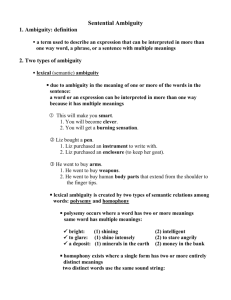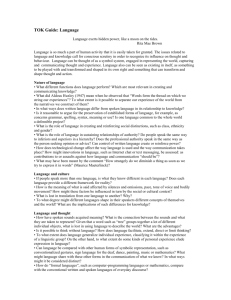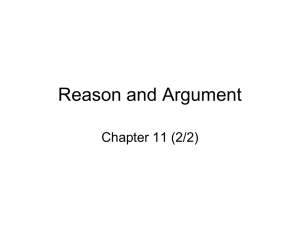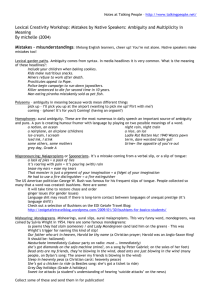LI2013 (12) – Semantics (for students)
advertisement
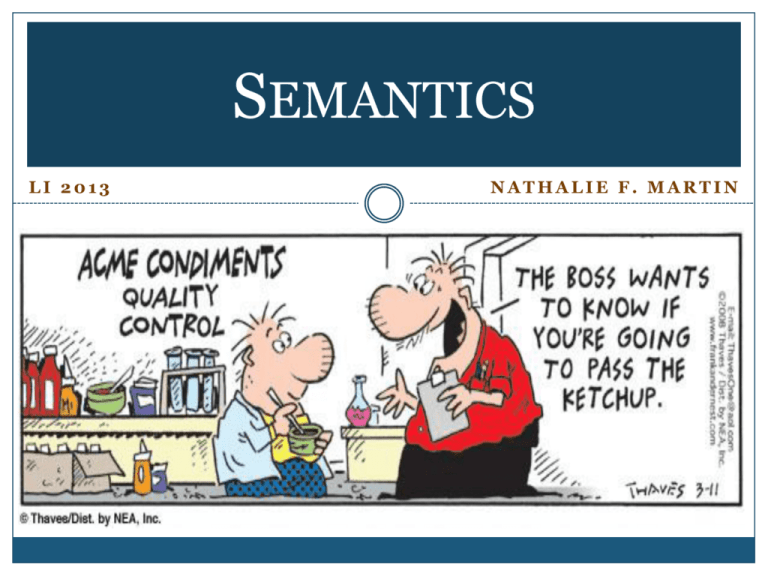
SEMANTICS LI 2013 NATHALIE F. MARTIN Table of Content 1. CONCEPT, REFERENT AND FORM 2. SEMANTICS 3. SEMANTIC RELATIONS AMONG WORDS 1. THE –NYMS 4. AMBIGUITY (REVIEW OF TEXT - STAGEBERG) 5. MEANING 6. MEANING OF WORDS THROUGH TIME References References: A Concise Introduction to Linguistics (Rowe & Levine, 2009; 153-173) Contemporary Linguistic Analysis (O’Grady & Archibald, 2009, p. 190-207) Ambiguity in College Writing (Stageberb, Norman C., in Linguistics at Work: A Reader of Application, by Dallin D. Oaks, 1998) Semantics Definition: Semantics Semantics is the study of the meaning of linguistic expressions, such as morphemes, words, phrases, clauses, and sentences. What is the Meaning of These words? Cold Behind Old Accent Fine Nobody Cool This Fly Getting in touch Dictionary Definition: Explaining Meaning http://dictionary.reference.com/browse/Cool?s=t CONTEXT is Key ! – Certain aspects of meaning change with the ____________________________ Nobody bought milk (store owner vs. room mates) X is old: “old” means different things depending on what X is (person, food, currency, place, friend…) Context is therefore very important!! Can you think of words or expressions that have more than one definition depending on the context? Semantics Two types of semantics: 1. _____________: meaning of words 2. _____________: meaning of utterances larger than words Semantic Relations Among Words THE –NYMS: 1.HYPONYM, HYPERNYM AND COHYPONYM 2.SYNONYM AND PARASYNONYMS 3.ANTONYMS 4.POLYSEMY 5.HOMONYM 1. 2. 3. Homonyms Homophone Homographs Web of words – Relations Among Words http://www.visualthesaurus.com/ 1. Hyponyms (Semantic Relations among Words) Hyponyms and hypernyms Hyponymy: Words whose meanings are _________instances of a more general word, e.g. isosceles and equilateral are hyponyms of the word triangle. Hyponyms and cohyponyms 1. Hyponyms (Semantic Relations among Words) Let’s organize these words: Dance (verb) Salsa Exercice Tango 2. Synonyms (Semantic Relations among Words) 2. Synonyms (Semantic Relations among Words) Synonymy: words that have the ____ meanings, e.g. start & begin. 2. Parasynonyms (Semantic Relations among Words) Parasynonymy: words that have _____________ meanings, e.g. stool & bench. Synonyms or Parasynonyms? Do they really have the same meanings? Are they interchangable? o Vacation = holidays o Youth = adolescent o Remember = recall o Purchase = buy o Big = large Synonyms & Parasynonyms Pride and Prejudice, a screenplay by Deborah Moggach The danger of parasynonyms and overextension Chapter 3 : 20 minutes into the movie http://dictionary.reference.com/ 3. Antonyms a. GRADABLE VS UNGRADABLE (or complementary) b. RELATIONAL: • • Converse Reversive Antonyms vs Synonyms Antonymy: words that are ________ in meanings, e.g. hot & cold. Synonymy or Antonymy Flourish – thrive Intelligent – stupid Casual – informal Flog – whip Drunk – sober a. b. c. d. e. synonym antonym synonym synonym antonym a. Gradable/ungradable antonyms Grading involves _________. When we compare two or more objects. Do the objects have the property to the same ______or not: … cold cool warm + hot … Gradable: “cold” and “colder” The weather is much colder this week than last week. Ungradable: “male” ٭John is as much male as Peter. ٭John is more male than Peter. a. Gradable/ungradable antonyms (continued) Exception: Normal language behavior: ungradable antonyms can sometimes be graded in speech. Example John is more of a bachelor than Daniel (i.e. more determined never to get married, partying, had never had a stable girlfriend, etc.) I am more alive now than ever (i.e. feeling more energetic, satisfied with my life, etc). b. Relational: Conversives There is a __________between both. Without one you don’t have the other. o o o o o Examples: Husband – wife Doctor – patient Master – mistress Before - after Above – below, etc. Often used to speak of reciprocal social roles, temporal and spatial relations. c. Relational: Reversives Another term: _____________. Examples: o Go up – go down o Come - go o Arrive – depart o Married – divorced You can reverse one by doing the other. Common feature: implication of _____in one of the two opposite directions _ _____________ Mind Mapping http://www.visualthesaurus.com/ Antonyms (review) Gradable or Complementary? (too, more, less, etc.) Relational: Conversive? (different points of view) Reversives? (one can reverse the other) Opposing POLYSEMY & HOMONYMY 4. Polysemy /pɒlisimi, pəlɪsəmi/ Semantic Relations among Words Polysemy: A word which has ___or more _______meanings e.g. bright: ‘bright light’ ; ‘bright colors’ A words' etymology is helpful in determining polysemy http://dictionary.reference.com/browse/polysemy http://www.merriam-webster.com/dictionary/polysemy?show=0&t=1290530170 5. Homonymy /həmɒnəmi/ Semantic Relations among Words Homonymy: A word which has __ or more _____________meanings Ex: Club: ‘a social organization’ ; ‘a blunt weapon’. Identifying Homonyms in Jokes 1. Time flies like an arrow Fruit flies like a banana 2. Policeman: Why have you parked your car here? Motorist: Because the sign says “Fine for Parking”. 3. Customer: Have you got half-inch nails? Ironmonger: Yes, sir. Customer: Then could you scratch my back. It’s very itchy http://www.merriam-webster.com/dictionary/nail Homonym, Homophone & Homograph Homophony: Different words _____________ but _____________ , ex. two and too. Homography: Different words _____________ but _____________, e.g. minute and minute. Homonyms are words that are ___homophones and homographs. Homonym, Homophone & Homograph Types of HOMONYMY: Homophone Homograph Homonym Same SOUNDS Same SPELLING X X Identifying homophones 1. [steər] 1. Stair, stare 2. [weist] 2. waste, waist 3. [si:lIη] 3. sealing, ceiling 4. [kju:] 4. cue, queue 5. [sent] 5. sent, cent, scent Identifying Homographs 1.Read /rid/ & /rɛd/ 2.Wind /wɪnd/ & /waɪd/ 3.Live /lɪv/ & /laɪv/ 4.Tear 5.Invalid 6.Bow 7.Dove Polysemy or Homonymy*? GRASS: herbage used for grazing animals; marijuana LEECH: a bloodsucking worm; a hangeron who seeks advantage RANGE: A cooking stove; a series of mountains KEY: An instrument used to apply to a lock; an answer sheet for tests or assignments RACE: the act of running competitively; people belonging to the same genetic grouping Homonymy or Polysemy ? PASS ? 6. Meronym / 7. Holonym PARTS OF A WHOLE Meronym: Part of a whole Holonym: The whole to which parts belong 8. Metonym Metonym: is a _____ ________where a thing is called by the name of something closely associated to it. Examples of METONYMS "ear" ex: means "attention” lending an ear “Washington” for the “United States government” ex: Washington passed a law “Sword” ex: for “military power” not by sword Examples of METONYMS Crown - in place of a royal person The White House - in place of the President or others who work there The suits - in place of business people Dish - for an entire plate of food Cup - for a mug The Pentagon - to refer to the staff The restaurant - to refer to the staff Examples of METONYMS Ears - for giving attention ("Lend me your ears!" from Mark Antony in Julius Caesar) Eyes - for sight The library - for the staff or the books Pen - for the written word Sword - for military might Silver fox - for an attractive older man Hand - for help Application: Bible Translation A case study of a polysemous word : I do not permit a woman to teach or to exercise authority over a man; rather, she is to remain quiet. 1 Timothy 2:12 (English Standard Version) Context: I allow no woman to teach or to have authority over men; she is to remain in quietness and keep silence [in religious assemblies]. 1 Timothy 2:12 (Amplified Bible) Polysemy and Cooccurance: “Woman” or “Wife” ? But I suffer not a woman to teach, neither to have lordship on the husband [neither for to have lordship on the man], but to be in silence. 1 Timothy 2:12 (Wycliffe New Testament) Key word Bible: Ambiguity Review of the text: Ambiguity in College Writing (Stageberb, Norman C., in Linguistics at Work: A Reader of Application, by Dallin D. Oaks, 1998) Multiple Meanings LEXICAL (or POLYSEMANTIC) AMBIGUITY E.g. For many purposes they used obsidian or volcanic rock. SYNTACTIC (or STRUCTURAL) AMBIGUITY E.g. a fat lady’s man CLASS (or PART-OF-SPEECH) AMBIGUITY: E.g. Many hands make light work. (in given example) SCRIPT AMBIGUITY: E.g. I am an outdoor lover. “lover of the Out-of-doors” … or … ? Ambiguity in College Writing (Stageberb) What Ambiguity? Lexical (or polysemantic) ambiguity? Syntactic (or structural) ambiguity? Class (or part-of-speech) ambiguity? Script ambiguity? What Ambiguity? Lexical (or polysemantic) ambiguity? Syntactic (or structural) ambiguity? Class (or part-of-speech) ambiguity? Script ambiguity? What Ambiguity? Lexical (or polysemantic) ambiguity? Syntactic (or structural) ambiguity? Class (or part-of-speech) ambiguity? Script ambiguity? What Ambiguity? Lexical ambiguity? Syntactic ambiguity? Class ambiguity? Script ambiguity? What Ambiguity? Lexical (or polysemantic) ambiguity? Syntactic (or structural) ambiguity? Class (or part-of-speech) ambiguity? Script ambiguity? What Ambiguity? Lexical (or polysemantic) ambiguity? Syntactic (or structural) ambiguity? Class (or part-of-speech) ambiguity? Script ambiguity? What Ambiguity? Lexical ambiguity? Syntactic ambiguity? Class ambiguity? Script ambiguity? Concept, Referent and Form PRELIMINARY THEORY TO SEMANTICS The Abstract Side of Language Don’t think of a pink elephant! Referent: the actual thing CONCEPT: the thought in our head SYMBOL: the associated sounds in our head [bərd] [bərd] Qu’est-ce que le langage? (Leclerc) Referent, Concept and SYMBOL [bərd] Ferdinand de Saussure Qu’est-ce que le langage? (Leclerc) Referent, Concept and Symbol The _______ refers to the linguistic elements (word, sentence, etc.), the _______ refers to the object in the world of experience, and THOUGHT or REFERENCE refers to _______ . Referent, Concept and Symbol Concept evokes Symbol Refers to There is not a direct link between the sound of the word dog (Symbol) and the object it refers to. Referent What is called the signified is not actually what we have been shown but an abstract concept formed in our mind. Stands for no direct relationship Ogden & Richards ROMEO AND JULIETTE (SHAKESPEARE) Juliet: 'Tis but thy name that is my enemy; Thou art thyself, though not a Montague. What's Montague? it is nor hand, nor foot, Nor arm, nor face, nor any other part Belonging to a man. O, be some other name! WHAT'S IN A NAME? THAT WHICH WE CALL A ROSE BY ANY OTHER NAME WOULD SMELL AS SWEET; So Romeo would, were he not Romeo call'd, Retain that dear perfection which he owes Without that title. Romeo, doff thy name, And for that name which is no part of thee Take all myself Review: The Abstract Side of Things SYMBOL CONCEPT Sounds bərd] -Mental representation of the sound -« acoustic image » (sound pattern) -A string of phonemes (sounds) -Psychic imprint - We refer to this mental imprint to understand when someone speaks Concept (mental representation of reality) -Psychic -Mental image of the referent -Common to speakers of that language (therefore conventional) Ferdinand de Saussure - Ex: covered in feathers, has a beak, etc. Concepts Across Languages WIN (English) = GAGNER (French) •Both are intransitive verb = Subject + verb DEVANCER (French) = “to pass”, “to move ahead” or “to be ahead” (English) •In the French word, there is more emphasis on the fact of “being ahead” than on the idea of passing. BEAT (English) … not really a French equivalent (in Standard French) •Transitive verb = Subject + verb + object So what happens when I want to say that I beat someone in French? •JE T’AI GAGNÉ (Litt. Translated: “I won you”) • transitive verb •JE T’AI BEATÉ (Acadian French) • transitive verb A FEW APPROACHES TO MEANING Connotation 2. Referents: 1. 3. Denotation Extension Intention: Semantic Analysis 4. Syntax: Word Combination What is “word meaning”? What does it mean when you say you know the meaning of a word? What does it mean when you say you know a word, such as “bird” “blue”, or “happy” ? How do we _______ of a word meaning? Approaches to Word Meaning Here are a few ways 3. to look at meaning: Connotation 2. Referents: 1. Denotation Extension 4. Intention: Semantic Analysis Syntax: Word Combination 1. Connotation « Set of associations that a word’s use can _______ » Ex: winter Let’s do some word mapping around the word winter ! This is not enough to define the meaning … 2. Referents: Denotation According to _______ _______ … To equate meaning to a word or phrase with actual entities to which it refers An animal that can bark dog Prime Minister of Canada Stephen Harper 2. Referents: Denotation To equate meaning to a word or phrase with actual entities to which it refers But what about imaginary things that have no referents !!! Referents: Denotation And what about words/expressions that have ___referents for one thing, for the same thing e.g. Stephen Harper the Prime Minister of Canada ‡ the leader of Conservative Party 3. Referents: Extension A word’s corresponds to the __________ that it _______ in the world (_______ ) Extension in Child Speech Overextension is when a child uses a word too broadly. Like if they called ALL males 'daddy' All animals 'dog' Extension in Child Speech Underextension is the opposite. For example, a child may only call black labs 'dog' but no other dogs. Ex: Calling their rattle a rattle, but calling other ones 'toys'. Extension in Child Speech Underextension Ex: Calling soft ball “balls”, but not when they are hard as in a pool ball. Extension often in Adults Underextension : Ex: Calling oranges and apples fruit, but not including tomatoes. KIDS SAY THE DARNDEST THINGS !!! My cousin's daughter looked at my feet the other day and saw the state of my torn shoes. She looked over to her mother and said: "Mommy, look. She has broken feet!“ Classic example of over-extension of “feet” :) Overextension Referents: Denotation vs.Extension A word’s corresponds to the set of entities that it picks out in the world (referents). To equate meaning to a word or phrase with actual entities to which it refers 4. Intention: Semantic Analysis ALSO CALLED: COMPONENTIAL ANALYSIS OR SEMANTIC DECOMPOSITION 4. Intention A word’s corresponds to its ____________ or the _______ that is _______ . * The distinction stipulates the relation between referents and meanings Contemporary Linguistics Analysis: p. 196 Intention: Semantic Analysis (or Distinctive feature Analysis ) Semantic properties: The _________ of meaning of a word. Distinctive feature Analysis: to illustrate semantic properties linguist’s use a notational system for expressing the ______ or _______ of semantic properties by “+” and “-”. Example of Distinctive feature Analysis analysis: “baby” is [+ young], [+ human] Intention: Semantic Analysis (or Distinctive feature Analysis ) SOW Definition: a fully grown female pig http://www.merriam-webster.com/dictionary/ Semantic Analysis: [+ animal], [+ pig], [- male] [+ adult] or [+ female] Intention: Semantic Analysis (or Distinctive feature Analysis ) [PIG] (species) [ADULT] [MALE] [FEMALE] PIG HOG SOW PIGLET + + +/+/- + + + - + + + + +/+/- Intention: Semantic Analysis (or Distinctive feature Analysis ) 1. (a) widow, mother, sister, aunt, maid (b) widower, father, brother, uncle, valet [+ ______] The (a) and (b) words are The (a) words are [+ ______] The (b) words are [+ ______] 2. (a) bachelor, paperboy, pope, chief (b) bull, rooster, drake, ram The (a) and (b) words are [+ _______] The (a) words are [+ _______] The (b) words are [+ _______] Intention: Semantic Analysis (or Distinctive feature Analysis ) 3. (a) table, stone, pencil, cup, house, ship (b) milk, alcohol, rice, soup, mud The (a) words are [+ _______] The (b) words are [] 4. (a) pine, elm, sycamore (b) dandelion, aster, daisy The (a) and (b) words are [+ The (a) words are [+ ] The (b) words are [+ ] ] Intention: Semantic Analysis (or Distinctive feature Analysis ) CAR Definition: A vehicle moving on wheels http://www.merriam-webster.com/dictionary/ Semantic Analysis: [+ vehicle], [+ motorized], [+ 4 wheels] … How would we know that it is not a truck? Intention: Semantic Analysis (or Distinctive feature Analysis ) BUTTERFLY Definition: any of numerous slender-bodied diurnal lepidopteran insects including one superfamily (Papilionoidea) with broad often brightly colored wings and usually another superfamily comprising the skippers http://www.merriam-webster.com/dictionary/ Semantic Analysis: [+ ], [+ ], [- ]… 5. Syntax Subcategorization of Verbs 2 COMPLEMENTS: Fax Radio Wire Phone Emphasis on: - ____________ NO COMPLEMENT: Murmur Mumble Mutter Shriek Emphasis on: - ____________ So there’s a link between _______ and _______ !!! The Word’s Context / Word Combinations THE IMPORTANCE OF WORD COMBINATION: An example: What is wrong with this sentence: The colorless green ideas sleep furiously. The Word’s Context / Word Combinations There are many reasons why two words cannot be combined: Meaning • Inherent meaning (ex: colorless green*) • Connotation (ex: sleep furiously*) • Semantic limits of words (ex: watched the intelligence*; or green ideas*) Syntax • Complements (ex: he closed the telephone*) • Subject (ex: the door danced*) A FEW APPROACHES TO MEANING Therefore: The colorless green ideas sleep furiously. “IDEAS” cannot have a color since it is [+ abstract] “FURIOUSLY” has to modify a verbs where one is conscious, amongst other things. “SLEEP” has a “restful” connotation. “FURIOUSLY” doesn’t. Something cannot be “colorless” and “green” at the same time. There is semantic contradiction here. Meaning of Words Through Time THE MEANING OF WORDS CAN EVOLVE INTO MORE POLYSEMANTIC MEANINGS Neologism (or Coinage) Neologism (or Using derivation: Coffeefy … Coinage) Evolution of Meaning Language Changes a lot, not just in adding new words here and there, but also as the meaning of these words change with time. o o « Cool » used to mean « not warm/cold ». Then the meaning changed. Now, « cool », is not really that « cool » anymore ! Evolution of Meaning = Polysemy BARRÉ (Acadian French): - Blocked door (with actual bar) - Blocked door (locked) - Blocked river - Blocked road This is how you get _______ Evolution of Meaning Lexicology MEANING AND DICTIONARIES Analogy Definition of the French words “PLUME”: 1. A feather 2. A feather used for writing (“plume-fontaine”) 3. A ball point pen (ou “stylo”) Definitions drawn out of a metaphor (or analogy). From Dictionary.com something concrete to something concrete. Choi-Jonin & Delhay, 1998 Analogy, Figurative Sense & Metonymy Definition of the words “SWORD” : 1. a weapon (…). 2. this weapon as the symbol of military power, punitive justice. authority, etc. Ex: The pen is mightier than the sword. war, combat, slaughter, or violence. 4. The Bible. 3. What meanings are drawn out of a certain metaphor? Analogy – from concrete to concrete: Figurative – from concrete to abstract: Metonymy: pen and sword Dictionary.com Choi-Jonin & Delhay, 1998



